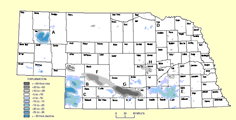Natural Resources, School of

Conservation and Survey Division: Faculty and Staff Publications
Document Type
Article
Date of this Version
1907
Citation
Condra, G.E. 1907. Opening of the Indian Territory. Bulletin of the American Geographical Society. 39(6): 321-340.
Abstract
The opening of Indian country has continued from Colonial days to the present. Usually it has resulted from force and treaty, the strong dispossessing the weak. As a result, the Red man has, in general, moved frontierward, ahead of industrial waves, remaining for a longer time only on reservations set aside for tribes. The Indian's struggle even on these reserves has been a losing one, resulting largely from war, disease, and the cupidity of whites. History shows that Indian life and Indian institutions have not prevailed against the white man's civilization and commerce. GATHERING THE TRIBES. The Indian Territory and Oklahoma together form a focal point in the Indian history of the United States. There, fully twentyfive tribes were concentrated from reservations in various States, coming from the north, east, south, and west. Plate I shows the distribution of the leading tribes. Most Indians entered the Territory by choice and treaty, yet there were cases of coercion and rank injustice on the part of the National Government and States. Of the smaller tribes, the Delawares, from the banks of the well-known river of the same name, were forced westward; placed on a reservation in Ohio in 1789; moved to Missouri about 1818 and to the Cherokee Nation in 1866, receiving allotments in severalty. The Shawnees came by a circuitous route, extending from their old "Kickapoo" home in Wisconsin to Tennessee, the Carolinas, New York, Ohio, and then to the Territory, where they abandoned tribal relations in 1854. The Ottawas lived in Michigan; the Miamis in Wisconsin; the Peorias along the southern end of Lake Michigan, and the Modocs in Oregon and California. In their early history the Senecas, a warring member of the Iroquoian Confederacy, were strongly established in Western New York. The Shawnees lived in the region of Virginia; fought the Cherokees and Chickasaws; were forced westward to Ohio and Kentucky by whites, and finally incorporated in the Cherokee Nation. This tribe is best remembered by the Tippecanoe Campaign and the hero, Tecumseh. Quapaws and other Siouan tribes, the Kaws, Osages and Poncas migrated from the east at an early date. This stock separated in the Ohio Valley, the Quapaws going to Tennessee and Arkansas and the other tribes to the north-west. Later the remnant of each tribe was taken to Oklahoma and the Territory. The five civilized tribes-the Cherokees, Creeks, Seminoles, Chickasaws and Choctaws, all of Muskogean stock, except the first named (which is Iroquoian)-were once powerful nations in the south-eastern part of the United States. They were caused to enter their reservations at times denoted by Plate 1. Summing up, we may say that the Territory has been the dumping-ground for remnants of tribes which formerly were located on reservations in States. Viewed in another way, it is a restricted area of an Indian country formerly large and little known. Most of the Indian Territory tribes are well known in history. Some of them strongly opposed our policy and fought us as early as Revolutionary times.
Included in
Geology Commons, Geomorphology Commons, Hydrology Commons, Paleontology Commons, Sedimentology Commons, Soil Science Commons, Stratigraphy Commons


Comments
RS-1320